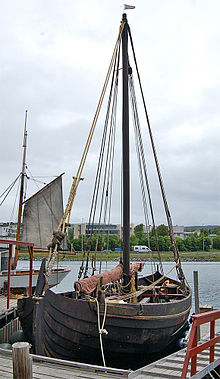Knorr (ship type)

The Knorr (also: Knörr, Knarr) was the type of ship with which the Vikings set out to conquer the North Atlantic Islands.
history
The Knorr was the packhorse on which the Vikings transported their merchandise across the seas, especially on their voyage to England. The name apparently comes from the "gnarled" branch that was used as stern . The two major disadvantages of this type were that the ship was slow and offered no protection for either crew or cargo. And yet, unlike the longships, the great transatlantic voyages were made with her . Olav II. Haraldsson drove with two such Knorr from England to Norway to take over the rule there. There were 260 armed men on them. Even if the report was written down centuries later, this seems to have been a plausible statement to the readers. A replica, the ' Saga Siglar ', impressively demonstrated the qualities of this type with a circumnavigation of the world between 1984 and 1986.
This particularly large type of ship among the merchant ships was of course also used as a warship during the war. However, it never got the same meaning as the longships. Nevertheless, it was actually the most suitable type of ship for the open sea. Only this type of ship sailed to Iceland, Greenland to the Shetlands and the Hebrides or the Faroe Islands. The fact that longships went to the Orkney were regularly for political and military reasons. With the Knorr, Greenland and Vinland were discovered. Even within this type of ship, there were adaptations to the respective areas of operation: Iceland, Baltic Sea, etc. Compared to the longship, the crew was also small; an Icelandic driver had 15-30 men on board.
In the sequence of early medieval northern European ship types, the Knorr is a relatively late development. This followed her the migration period represents rowing boats, by the Nydam ship and the longships of the Viking Age Scandinavia and Northern Europe (9th-11th century) as a typical Viking ships with the combination of oars and sails, represents e.g. B. by the Oseberg ship . Small ferry boats and larger cargo ships like the Knorr are also from the Viking Age. Last but not least, the name "knörr" is associated with a busty woman ( knarrar-bringa ).
Corresponding finds were only made in the 1960s and 1980s at the ship cemetery at Skuldelev (near Roskilde ), in Galtbäck and in the port of Haithabu . Shorter than the longship, but wider, more high-sided and generally sturdier, a Knorr could carry enormous loads ( Skuldelev I up to 24 tons, Haithabu III up to 40 tons). The central, open hold took up almost half of the ship; Fore and aft there were raised platforms, so-called half-decks. She drove almost exclusively under sails, two to four pairs of oars were used for maneuvering in narrow waters or port entrances.
See also
literature
- Jan Bill: Ships and seamanship . In: Peter Sawyer (Ed.): The Vikings. History and culture of a seafaring people . Stuttgart 2000, pp. 192-211.
- AW Brøgger and Haakon Shetelig: Vikingeskipene. Their forgjengere and etterfølgere . (Viking ships. Their predecessors and successors). Oslo 1950.
- James Graham-Campbell. The life of the Vikings. Warriors, traders and explorers . Berlin 1980, ISBN 3-607-00008-5 .
- Magnus Magnusson: The Vikings. History and legend . Düsseldorf u. a. 2003, ISBN 3-538-07152-7 , pp. 22-26, 44 ff., 193 f.
- Olaf Olsen, Ole Crumlin-Pedersen: Five Viking Ships from Roskilde Fjord , translated by Walter Jürgensen. 2nd Edition. Roskilde 1990, ISBN 87-480-0182-1 .
- Rudolf Simek: The Vikings (CH Beck knowledge in the Beck'schen series, volume 2081). 3. Edition. Munich, ISBN 3-406-41881-3 .
- Rudolf Simek: The ships of the Vikings . Reclam, Stuttgart 2014, ISBN 978-3-15-010999-1
Web links
- NAVIS Database of ancient ships (English)
- Haithabu III
- Skuldelev I (English)
Individual evidence
- ↑ Ordericus Vitalis : Historia Ecclesiastica VIII, 23 (for the year 1095): "quatuor naves magnae, quas Canardos vocant, de Northwegia in Angliam appulsæ sunt." (Four large ships called Knorr landed in England from Norway.)
- ↑ Alexander Johannesson: Icelandic etymological dictionary . Bern 1956. p. 333.
- ↑ Heimskringla. The story of Olav the Saint . Cape. 29
- ↑ a b c Brøgger p. 286.

